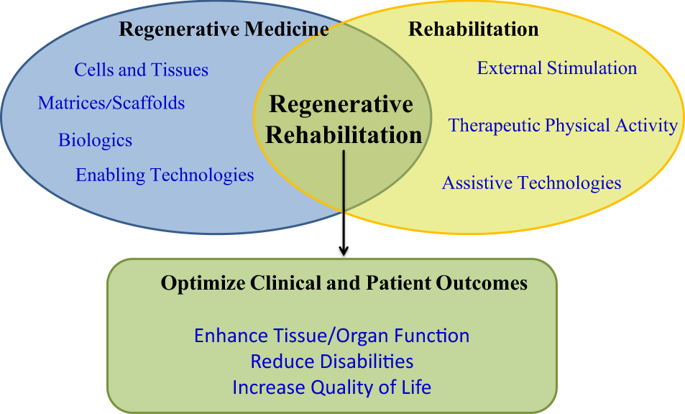npj Regenerative Medicine ( IF 6.4 ) Pub Date : 2018-10-10 , DOI: 10.1038/s41536-018-0056-1 L. F. Rose , E. J. Wolf , T. Brindle , A. Cernich , W. K. Dean , C. L. Dearth , M. Grimm , A. Kusiak , R. Nitkin , K. Potter , B. J. Randolph , F. Wang , D. Yamaguchi

|
Regenerative rehabilitation is the synergistic integration of principles and approaches from the regenerative medicine and rehabilitation fields, with the goal of optimizing form and function as well as patient independence. Regenerative medicine approaches for repairing or replacing damaged tissue or whole organs vary from utilizing cells (e.g., stem cells), to biologics (e.g., growth factors), to approaches using biomaterials and scaffolds, to any combination of these. While regenerative medicine offers tremendous clinical promise, regenerative rehabilitation offers the opportunity to positively influence regenerative medicine by inclusion of principles from rehabilitation sciences. Regenerative medicine by itself may not be sufficient to ensure successful translation into improving the function of those in the most need. Conversely, with a better understanding of regenerative medicine principals, rehabilitation researchers can better tailor rehabilitation efforts to accommodate and maximize the potential of regenerative approaches. Regenerative rehabilitative strategies can include activity-mediated plasticity, exercise dosing, electrical stimulation, and nutritional enhancers. Critical barriers in translating regenerative medicine techniques into humans may be difficult to overcome if preclinical studies do not consider outcomes that typically fall in the rehabilitation research domain, such as function, range of motion, sensation, and pain. The authors believe that encouraging clinicians and researchers from multiple disciplines to work collaboratively and synergistically will maximize restoration of function and quality of life for disabled and/or injured patients, including U.S. Veterans and Military Service Members (MSMs). Federal Government agencies have been investing in research and clinical care efforts focused on regenerative medicine (NIH, NSF, VA, and DoD), rehabilitation sciences (VA, NIH, NSF, DoD) and, more recently, regenerative rehabilitation (NIH and VA). As science advances and technology matures, researchers need to consider the integrative approach of regenerative rehabilitation to maximize the outcome to fully restore the function of patients.
中文翻译:

再生医学与康复的融合:联邦政府的观点
再生康复是再生医学和康复领域的原理和方法的协同整合,其目标是优化形式和功能以及患者独立性。修复或替换受损组织或整个器官的再生医学方法,从利用细胞(例如,干细胞)到生物制品(例如,生长因子),再到使用生物材料和支架的方法,到这些方法的任意组合,都不同。再生医学具有巨大的临床前景,而再生康复则提供了通过纳入康复科学原理来积极影响再生医学的机会。再生医学本身可能不足以确保成功转化为改善最需要者的功能。反过来,通过对再生医学原理有更好的了解,康复研究人员可以更好地调整康复工作,以适应并最大程度地发挥再生方法的潜力。再生性康复策略可以包括活动介导的可塑性,运动剂量,电刺激和营养增强剂。如果临床前研究未考虑通常属于康复研究领域的结果,例如功能,运动范围,感觉和疼痛,则很难克服将再生医学技术转化为人类的关键障碍。作者认为,鼓励多学科的临床医生和研究人员进行协作和协同工作,将最大程度地恢复残疾和/或受伤患者的功能和生活质量,包括美国退伍军人和军事人员(MSM)。联邦政府机构一直在投资于针对再生医学(NIH,NSF,VA和DoD),康复科学(VA,NIH,NSF,DoD)以及最近的再生康复(NIH和VA)的研究和临床护理工作。 。随着科学的进步和技术的成熟,研究人员需要考虑再生康复的综合方法,以最大限度地提高治疗效果,从而完全恢复患者的功能。











































 京公网安备 11010802027423号
京公网安备 11010802027423号